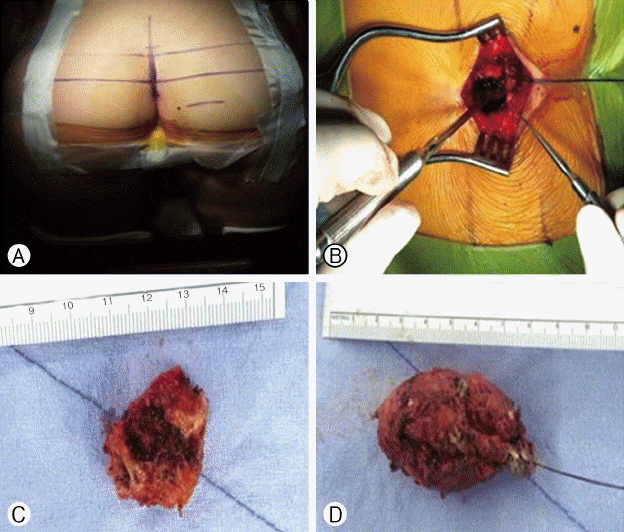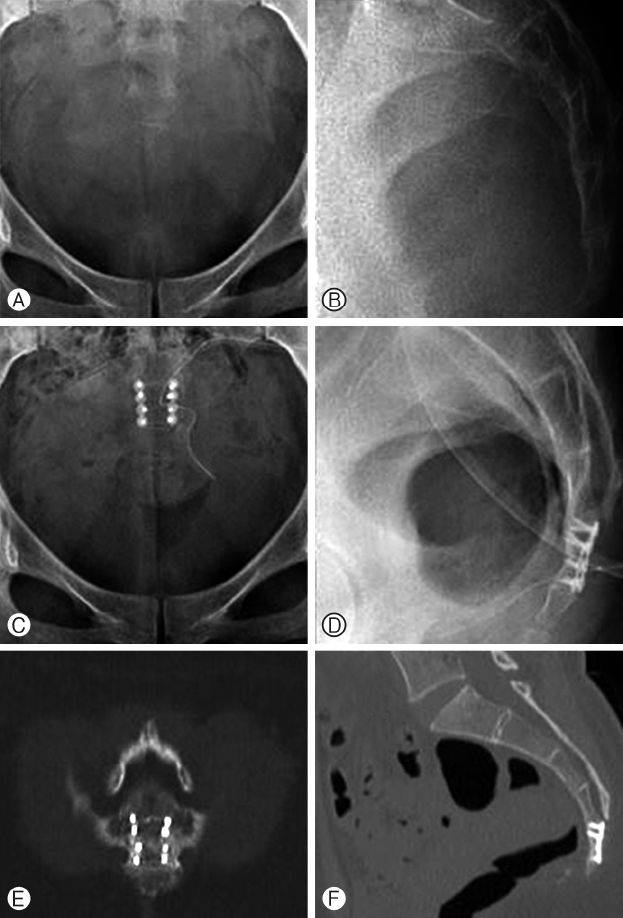INTRODUCTION
The presacral tumor is an uncommon tumor and it has potential malignant transformation8,18). Diagnosis is usually delayed because it presents clinical symptoms raised from affecting structures by compression of tumor mass in late period of tumor growth5,7).
Posterior approach is preferred for small, benign lesions that do not extend above the level of the S2 vertebrae. The posterior approach is comprised of many techniques including the transsphincteric, transsacral, transrectal, transanorectal, and transsacrococcygeal approaches. Transcoccygeal approach only maintains anal sphincter and sacrum2). It is easy to access to lower lying presacral mass. Coccygeoplasty can maintain functions of coccyx and prevent surgery related injuries of anal sphincter and sacrum.
We present a 24-year-old female patient that underwent resection of a presacral tumor through posterior coccygeoplasty and review pertinent literature.
CASE REPORT
A 24-year-old woman had been treated with medication because of acute pyelonephritis for 3 weeks without improvement. She underwent computed tomography (CT) scan and magnetic resonance imaging (MRI) for further evaluation that revealed a 6.3cm-sized high density non-enhancing cystic lesion in the presacral area. Ovaries and uterus were intact (Fig. 1). There was no evidence of adenopathy or metastatic disease within the abdominal cavity. Physical examination revealed normal sphincter tone, normal flexibility of perianal soft tissue, and an empty rectal vault with extrarectal fullness posteriorly reachable with the fingertip.
Posterior approach was conducted for total resection of tumor. Patient was placed in the prone jack-knife position with the buttocks spread (Fig. 2A). After an incision over the lower portion of the sacrum and coccyx down to the anus was conducted, the anococcygeal ligament was dissected and levator ani muscles were laterally retracted to obtain optimal surgical window approach to the presacral space (Fig. 2B). To provide good exposure, excision of the coccyx (coccygectomy) was necessary (Fig. 2C). Coccygotomy was conducted in a middle portion of coccyx because a part of bony coccyx should be retained for reconstruction of coccyx. Careful dissection was conducted to separate the tumor from the rectum and grossly total resection of tumor was conducted successfully (Fig. 2D). Reconstruction of coccyx was conducted using mini-profiled locking plates and monocortical (6mm length; 2.4mm diameter) locking screws (ARCH DePuy Synthes, Raynham, MA, USA). Bone dusts were packed into the bony cap between coccygectomy bone flap and remained coccyx. Wound closure was completed after irrigation and meticulous hemostasis.
DISCUSSION
The presacral tumor is an uncommon tumor and may grow larger or become a malignant tumor8,13,20). About one-third of presacral tumors are congenital7,8,19); neurogenic and osseous are approximately 10% respectively, and etc.8). Approximately 10% of teratoma are transformed into malignancy in a few years6,8). Chordoma is most common solid retrorectal tumor3,4,7,8).
The method of diagnosis is varied. CT and MRI are effective in finding the size and position of tumor, relative to surrounding organs as well as other pertinent information. Biopsy is recommended for tissue confirmation despite possibility of post-procedure infection8). In addition, it may be routes of proliferation of malignant tumor cells.
Presacral tumor occasionally reveals non-specific symptoms3-5,8) such as abdominal pain, bowel habit change, constipation, and inguinal area pain. This often makes a diagnosis complicated and may produce a wrong diagnosis8,10,12,17,20).
Surgical removal of presacral tumor is preferred for reducing infection, preventing malignant transformation, and making an accurate diagnosis15,21).
Anterior and posterior surgical approaches may be applied for surgery of presacral tumor17). Selection of surgical approach depends on the size and position of tumor and if it has invaded surrounding organs12). The abdominal approach is usually conducted for these lesions that have their lowest extent above the level of the S4 vertebrae and do not have evidence of sacral involvement. Anterior approach is suitable for the tumor of upper sacral promontory20). Laparoscopic approach to removing these tumors is a safe and feasible for a part of presacral tumors1,11).
Posterior approach is preferred and familial for small, benign lesions that do not extend above the level of the S2 vertebrae2). The posterior approach is comprised of many techniques including the transsphincteric, transsacral, transrectal, transanorectal, and transsacrococcygeal approaches. Transcoccygeal approach only maintains anal sphincter and sacrum2). It is easy to access to lower lying presacral mass. But, transcoccygeal approach needs resection of coccyx. Coccygeoplasty can maintain functions of coccyx and prevent surgery related injuries of anal sphincter and sacrum.
Coccygotomy should be conducted in a middle portion of coccyx and a part of bony coccyx should be retained. Bone on bone fusion should be conducted for complete reconstruction of coccyx and final X-ray revealed stable reconstruction and bony fusion for this patient (Fig. 4).
Transsphincteric approach may cause sphincter deterioration9,14,16) and transsacral approach may cause hip discomfort and fistula11,20). Even though posterior approaches cannot be entirely excluded from surgery related complications, coccygeoplasty has merits such as presacral organ protection, stability in sacrococcygeal area, and stable sitting position.















